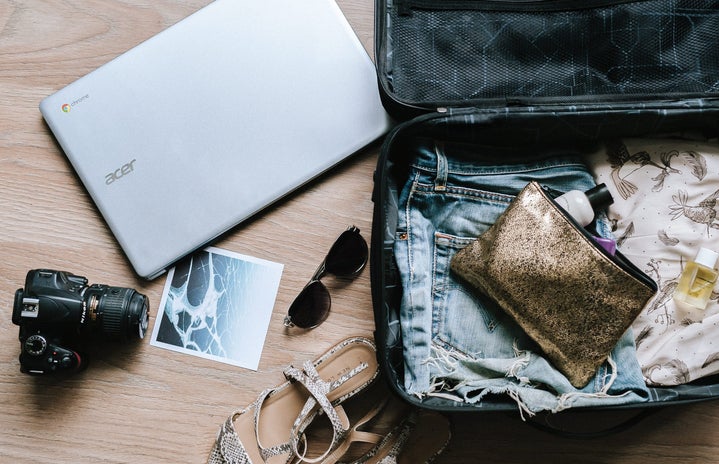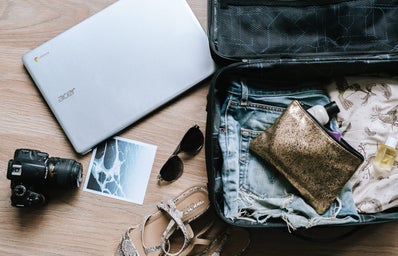Spring break is fast approaching. What does that mean?
Travel.
I love to take advantage of breaks from school to travel around the world. Catching a plane to a new destination gives me a rush like nothing else.
Traveling to new places means new questions and plans. It just comes with the territory.
Leaving the country, or even the state, can be intimidating. That’s why I’m here.
I’ve traveled to Mexico a few times over the past few years and plan to return in the near future.
Here’s how to make the most of your spring break trip in Mexico, crafted from my own experiences.
- Safety
-
Let’s get the biggest concern out of the way first: safety. Mexico gets a bad wrap, especially in western media coverage.
This is how I see it, wherever you go there might me danger. Mexico is no different. We experience violence in the United States quite often. That doesn’t stop people from traveling here.
This isn’t to say there is no danger in Mexico. Just as in every other new place you visit, be aware and be prepared.
Stick to well light and populated areas, try not to go out too late at night, be aware of your surroundings, and trust your intuition.
In all of my trips there, I have never felt unsafe. If you are lost or confused, find a local that you are able to communicate with. In my experience, most people are willing to help you.
Keep your belongings close to you. If you have items in your pockets, keep them in the front. As for purses, try to get a durable purse with a zipper, and keep it close to your body.
Be aware in crowded spaces. Like other large cities, pick pockets are a possibility.
This isn’t the trip to flaunt your new Rolex or Gucci belt. Wear a cute outfit, but don’t flaunt your wealth. Making it obvious that you have money or something valuable on you will draw unwanted attention.
The violence you see covered in the media shouldn’t scare you away from visiting this beautiful country. These suggestions shouldn’t scare you either. Every traveler should be aware of their surroundings and prepared, but not afraid.
Just do your research before you go. Check out the area you’re planning to visit online and see what other travelers and locals say. Being prepared and well informed is your best safety net.
- Language
-
Spanish isn’t as hard to learn as you may think.
From what I’ve experienced, many locals and business clerks speak English in touristy areas. I usually found someone I could communicate with in English before I was able to speak Spanish.
While you might be able to find someone to speak English with, I recommend learning some basic Spanish. Download Duolingo! Practice ordering some food. Listen to some music in Spanish and look at the English lyrics. Listening to Selena helped me learn Spanish.
Your grammar doesn’t have to be perfect, just understandable. The locals I interacted with while attempting to speak Spanish were happy that I was trying and were happy to help me.
Don’t expect someone to understand your English there, it isn’t the common language of the country. Be patient, people will often talk slower and use hand motions to help you understand. This is done for your benefit, so return the favor with gratitude.
Google translate or translator apps are also a huge help, but try not to rely on them. Internet and service can be unreliable in different parts of Mexico.
- Money
-
Let’s talk pesos.
I’ve had a few friends ask me what is better to bring with them: pesos or a credit card?
The answer I’ve always given is both.
Having pesos on hand is great to use for tips, buying from artists, grabbing some elote on the street and much more.
I don’t recommend carrying a large amount of cash on you. Grab a few bills for the day and try to reserve them for when card isn’t accepted.
Keep in mind, exchanging pesos for dollars again will likely result in you losing a bit of money. Try not to bring too much more than you expect to spend.
Many stores and restaurants will accept American credit and debit cards. I was able to use my Wells Fargo and Capital One cards. Check with your bank on what their policies are regarding foreign purchases.
- Food & Water
-
Traveler’s tummy is a rite of passage for every new traveler. Fear not, I’m here to help you avoid it, or at least try to.
Don’t drink the tap water. The tap water isn’t necessarily dirty, but it isn’t always as filtered as we’re used to. Locals only drink bottled water.
The tap water is perfectly fine to cook with, as long as it will be boiled or heated. The little bit you swallow while you brush your teeth isn’t something to worry about.
Bottled water is easy to find, check corner stores. It is also common for Airbnb’s to have water dispensers. You can find large five-gallon water bottles at corner stores and grocery stores.
Don’t be afraid to try street food. Some of the best food I’ve ever had was ordered from a guy using a makeshift cart and eaten on the side of the road.
If you’re worried if the food is safe to eat or tasty, look to see if locals are ordering from the cart. They know the best spots, don’t be afraid to ask them! My favorite snack is esquites, corn in a cup with a bunch of yummy toppings.
Restaurants are usually a safe bet. I personally have not gotten sick from eating at a restaurant in Mexico, just check for reviews online. Usually, there will be a Yelp page for restaurants if they are in a touristy area.
If you plan on cooking, don’t be alarmed by the food storage in markets. Unlike here in the United States, I’ve seen packaged meat on ice instead of in refrigerated spaces. There are also little local markets where they butcher the meat in front of you. Usually this meat is fresh. There are often fewer preservatives when you buy from these little markets, so be sure to cook the meat within a few days of buying it.
No matter how cautious you are, something is bound to upset your stomach. Keep some tums and water on you. I’ve had an upset stomach in Mexico, but nothing that ruined my trip.
- Transportation
-
Transportation varies depending on where you’re traveling.
I frequent Mexico City the most and thus I’m more familiar with their public transportation. Metro tickets are five pesos and it doesn’t vary depending on how far you’re traveling. The trains are fast and usually reliable but be prepared to be squished. Rush hour, lunch hour, and early mornings will have you packed in like sardines in the metro cars.
If you do go on the metro, keep your bag in front of you and remove everything from your pockets. You’ll see vendors on the train sellings snacks or small items. In my experience, once you tell them no thank you, they leave you be.
If the metro isn’t your style, taxis and app-ordered rides are common. I haven’t used Lyft, but I used Uber often.
Uber rides were fairly affordable in my opinion. For example, a ride from the airport to my Airbnb was about $20.
With this being said, driving is a lot different in Mexico than it is in the United States. In my experience, the manner of driving is much more aggressive. People often are cutting in and out of traffic, turning where they shouldn’t and honk at everything. This is common. If your Uber driver is driving like this, don’t be afraid or frustrated. They know what they’re doing.
Every city is different, so check out what public and private transportation your destination offers. If they have a metro or bus line, take a screenshot of the map and schedule to keep on hand.
- Souvenirs & Artisan Products
-
I adore grabbing a cool souvenir to remember my trip. My favorite souvenir from Mexico is an alebrije figurine, even though they tend to be on the expensive side.
If you’re looking for unique gifts, I recommend searching for artisan markets in the place you plan to visit. For example, I went to one in Mexico City that covered almost an entire block. There were hundreds of stalls with beautiful handmade goods.
If you do go the artisan product route, try not to haggle with the shopkeepers too much. Bartering is commonplace in these markets. They will often give you a price that you can talk them down from, but only by a bit.
In my experience, going too low in a counter-offer can be seen as offensive. Much of what they sell is intricate and handmade. Many shopkeepers stock their stores with their own work. Others import the items from various states.
I have spoken to a few shopkeepers who were upset by tourists complaining about the prices. They had a similar sentiment that they ask for certain prices due to the effort and time put into the item.
My best advice is only go as low as 100 to 150 pesos below what they asked for for larger items. For the smaller ones, I recommend not pushing below 50 pesos off of their original price. If you’re buying multiple items, you might be able to get a better discount.
I hope these tips are helpful for you, my future traveler. This is not by any means the only article you should read in preparation for your trip. Remember to do your research and have fun!
Is there any advice you would give a traveler? Let us know @HerCampusSJSU


